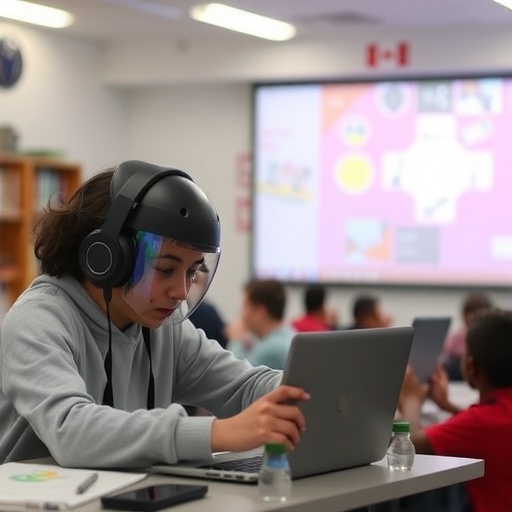In an era where technological advancements shape education, the need for effective teaching methodologies becomes increasingly critical. Ukrainian educators are actively responding to this challenge by integrating a STEM (Science, Technology, Engineering, and Mathematics) approach with universal design for learning (UDL). This innovative pedagogical framework aims to enhance digital competence among secondary school students, especially in the field of computer science. This comprehensive understanding not only aligns with global education trends but also prepares students for future careers in a digital world.
The transformative power of STEM integration cannot be understated. As technology continues to evolve, it has become imperative for educational institutions to adopt curricula that reflect these changes. In Ukrainian secondary schools, educators are now embedding STEM principles into their lessons while focusing on the essential skills required for navigating a digital landscape. By doing so, they’re not only enhancing students’ engagement but also equipping them with the problem-solving skills necessary for tomorrow’s challenges.
At the core of this educational shift is the concept of universal design for learning, which seeks to optimize teaching and learning for individuals with diverse learning needs. By leveraging UDL principles, educators are finding new ways to make learning more accessible and inclusive. This approach acknowledges that students learn in various ways and that traditional teaching methods may not meet every learner’s needs. Thus, a blended strategy incorporating UDL into STEM education helps address these disparities and encourages all students to thrive.
Moreover, the intersection of STEM and UDL cultivates an environment where collaboration flourishes. Project-based learning serves as an effective vessel for this collaborative spirit. In a project-based curriculum, students work together to explore complex problems, engage in critical thinking, and develop solutions that reflect real-world challenges. This strategy not only sharpens their technical skills but also fosters teamwork, communication, and creativity, which are integral components of the 21st-century skill set.
The integration of digital tools into lesson plans further enhances students’ learning experiences. From interactive simulations to programming languages, these resources enable students to experience firsthand the principles they are studying. As they navigate through these digital landscapes, students develop computational thinking and digital literacy, essential components for their educational journey in today’s technology-driven society.
Educators implementing this innovative framework are also focusing on professional development to ensure they are well-equipped to teach these subjects effectively. Training sessions that emphasize the importance of STEM and UDL help teachers feel more confident in integrating these components into their lessons. By investing in teacher training, Ukrainian schools are making significant strides towards fostering a literate generation capable of meeting the demands of the modern workforce.
Assessment plays a pivotal role in this educational framework as well. Traditional testing methods often fail to capture the complexities of student learning. Therefore, educators are exploring alternative assessment strategies that better reflect students’ competencies. Portfolio assessments, for example, allow students to compile and showcase their work, demonstrating not only their understanding of concepts but also their growth and creativity throughout the learning process.
The benefits of this educational approach extend beyond the classroom. As students become more digitally competent, they are empowered to engage with the wider community. Whether it’s through participating in local tech events, collaborating with industry professionals, or contributing to online platforms, these young learners are becoming active participants in a global digital community. This involvement cultivates a sense of agency and responsibility among students, encouraging them to be innovators and creators rather than mere consumers of information.
Moreover, the cultural implications of this educational shift should be considered. In a country like Ukraine, where there is a strong emphasis on tradition and conventional educational approaches, integrating STEM and UDL serves as a pioneering initiative that may spur further reforms in the educational landscape. As students begin to embrace these modern methodologies, they may inspire a broader cultural shift towards valuing innovation, creativity, and adaptability in both educational settings and society at large.
The integration of this pedagogical framework is not without its challenges. Resistance to change can emerge from various stakeholders, including educators, parents, and administrators. However, evidence demonstrating the efficacy of STEM-UDL approaches in improving student learning outcomes is persuasive. As more schools adopt these methods and share success stories, it encourages others to join the movement and illustrates that overcoming traditional educational barriers is possible.
Ultimately, enhancing digital competence through this innovative educational framework aligns with global trends aiming to prepare students for success in a rapidly changing world. Ukraine’s commitment to reforming its educational practices demonstrates a visionary approach toward equipping the next generation with the skills needed for future challenges. The continued evolution of educational strategies centered around STEM and UDL has the potential to not only revolutionize computer science education but also to empower students as capable, forward-thinking individuals prepared to contribute to society in meaningful ways.
In conclusion, the integration of a STEM-centric educational framework enriched by universal design for learning represents a significant leap forward for Ukrainian secondary schools. As these frameworks are developed and refined, they underscore the importance of inclusive, accessible, and engaging education in nurturing a digitally competent workforce. By recognizing the unique needs of all learners and embracing innovative teaching methods, educators are laying the groundwork for a brighter future where every student can thrive.
Subject of Research: Enhancing digital competence through STEM-integrated universal design for learning in Ukrainian secondary schools.
Article Title: Enhancing digital competence through STEM-integrated universal design for learning: a pedagogical framework for computer science education in Ukrainian secondary schools.
Article References:
Barna, O.V., Kuzminska, O.H. & Semerikov, S.O. Enhancing digital competence through STEM-integrated universal design for learning: a pedagogical framework for computer science education in Ukrainian secondary schools. Discov Educ 4, 357 (2025). https://doi.org/10.1007/s44217-025-00821-y
Image Credits: AI Generated
DOI:
Keywords: STEM, universal design for learning, digital competence, computer science education, Ukrainian secondary schools.




